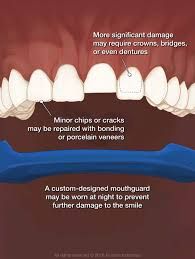Bruxism simply means excessive mastication outside functional purposes . It known by dental professionals as parafunctional activity which is far away from the what the oral cavity is well known for which is speech and mastication of food particles.
However, bruxism is a well known common behavior; the global prevalence of bruxism (both sleep and awake) is around 22.22%. Several symptoms are closely related to bruxism, including aching pain and tenderness of jaw muscles, headaches, hypersensitivity of teeth, tooth damages, dental restorations breakages (e.g. crowns and fillings).
Symptoms may not be excessive, even without patient awareness of the condition at the earlier stage, though if nothing is done, after a while many teeth start wearing down on a larger scale until the whole tooth is gone and worn off completely.
There are two main types of bruxism: sleep (nocturnal bruxism) bruxism and one during consciousness/wakefulness (awake bruxism).
The main causative factors of bruxism are not completely known, but may involve multiple factors. Conscious bruxism is more observed in women, whereas men and women are affected in equal proportions by sleep bruxism. Conscious bruxism is thought to have different causes from sleep bruxism.
Wide variation exists in reports in epidemiologic data for bruxism, and it is because of the differences in definition, diagnosis and research methodologies of these studies. Some uses self in reports which is considered a little bit biased form of reporting.
The ICSD-R reports show that 85–90% of people tend to grind their teeth at a certain point in their life cycle, although only 5% tends to show clinical manifestations.
"Children are reported to brux as commonly as adults. It is possible for sleep bruxism to occur as early as the first year of life, after the first teeth (deciduous incisors) erupt into the mouth, and the overall prevalence in children is about 14–20%. The ICSD-R states that sleep bruxism may occur in over 50% of normal infants. Often sleep bruxism develops during adolescence, and the prevalence in 18- to 29-year-olds is about 13%. The overall prevalence in adults is reported to be 8%, and people over the age of 60 are less likely to be affected, with the prevalence dropping to about 3% in this group."Source
Happy Blogging and Reading 💥💥💥🦷
Video from Dentalk YouTuber




